When it comes to planting onion sets in the spring, a few little planting secrets can make all the difference in helping your onions grow better, bigger and tastier!
Onions are one crop that cause a lot of confusion for gardeners. And it’s easy to see why. There almost seems to be an endless string of ways to plant and grow them. You can plant onions with bulbs (sets), transplants or by seed.
Adding to the confusion is knowing when to plant them. In some climates, it’s best to only plant onions in the spring. For other areas, they can be planted in the spring or fall. And of course – the timing also depends on whether you are planting sets, seed or transplants!
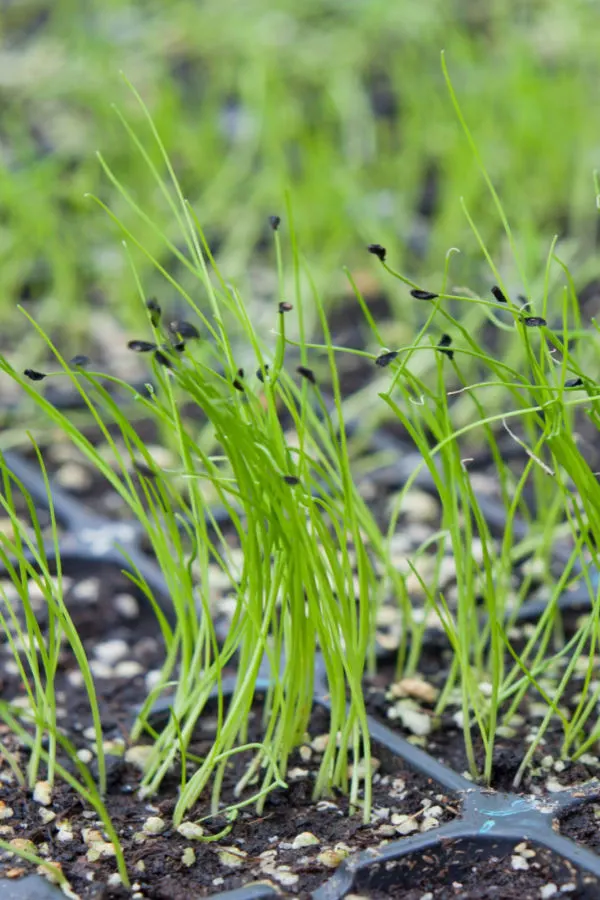
But today, we hope to end all of that confusion. Well, at least when it comes to planting onion sets in the spring – which can be done almost anywhere you live with success. With that in mind, here is a look at a few simple tips to help you get the most from your crop!
Why Planting Onion Seeds & Transplants Can Be Difficult
Although all of the methods for planting onions above will work, planting onion sets is really the best way to ensure a sizable harvest year after year. Especially when planting in the spring. See : Should You Plant Onion Seeds Or Onion Sets?
Although seed is the least expensive way to plant, spring seeds take a long time to germinate and grow. In fact, so much time, that some long-season onion varieties have a lot of trouble reaching full maturity by fall. It can lead to a disappointingly small harvest when planting seeds.
Planting by seed also has another disadvantage, they are hard to weed and thin. Onion seeds are tiny. Because of that, planting them in a garden or even a raised bed area can be tough. As can being able to weed them after they sprout!
The sprouts of onions are extremely small and thin. Being able to tell the difference between a young weed and an emerging sprout can be almost impossible. Unfortunately, if the weeds remain, they crowd out the onions, and that will lead to a much smaller harvest with smaller sized onions.
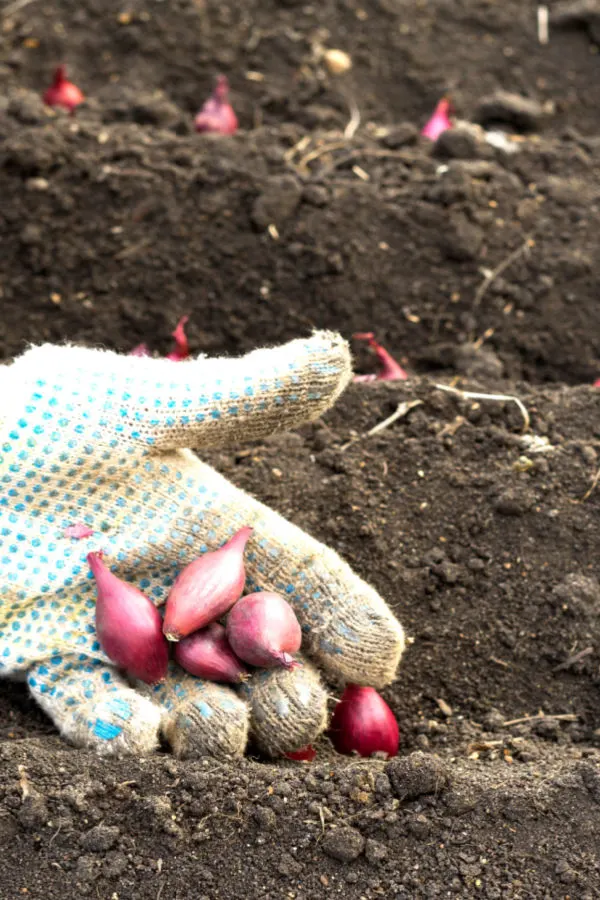
Why Not Onion Transplants?
What about onion transplants? Onion transplants are onion seeds that have been sprouted to a few inches. Although they are easier to plant, weeding around the small seedlings can still be tough.
Even worse, even though they have the advantage of a few extra weeks of growth, in most areas, there is still not enough time in a single season to grow full-size onion bulbs. So that leaves onion sets – which just happen to be the perfect answer for fast growing spring bulbs!
The Advantages Of Spring Planting – The Secrets To Planting Onion Sets In The Spring
Onion sets are onion seeds that have been sprouted and allowed to grow to a small onion. They are then harvested and allowed to go dormant. But when you plant the bulb back into the soil in the spring, it returns to life to grow once again.
Because the onion set bulb has a head start, it has the opportunity to finish its growing cycle much faster. That means even in areas with shorter growing days the onion can grow to full size. That extra growth allows it have a better flavor profile.
Onion sets can produce onions that are ready for harvest quickly. Especially when compared to seed or seedling planting in the spring. How much faster? As much as two, to two and a half months earlier!

The Secrets To Planting Onion Sets In The Spring
Selecting Onion Sets For Growing – Picking The Right Size
You can find onion sets in most garden centers and feed stores in early spring. They are also widely available on line if you happen to live in a location where they are difficult to find. For those that have trouble finding them locally, we have affiliate onion set links below that are available for purchase on line.
Although there are many varieties, almost all onion sets will come in 3 main types – yellow, red, or white. Selecting which variety to grow really comes down to personal preference – but all will plant and grow the same way.
- Stargazer Mixed Red, White and Yellow Onion Sets
- Stargazer Yellow Stuttgarter Onion Sets
- Stargazer White Ebenzer Onion Sets
When selecting onion sets, the size of the bulbs in your set is very important. For best results, you want to select sets with smaller, more compact bulbs. Always avoid sets with overly large bulbs. Although you might think that larger bulb sets would yield bigger and better onions, they actually are harder to grow than smaller bulbs.
Large bulbs are unfortunately close to their final growing stage. Because of this, they often bolt early in the growing season before ever maturing. In addition, with the shorter time in the soil, they are unable develop a more robust flavor profile.
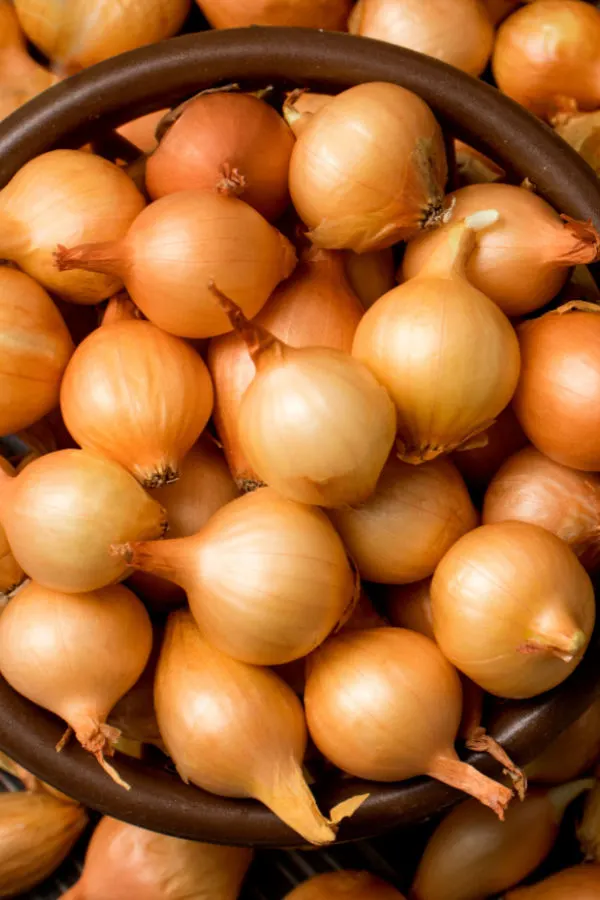
With that in mind, stick with onion set bulbs that are three-quarters of an inch in diameter. These are large enough to grow to full size without the worry of bolting or developing a tough outer skin or interior layers.
How To Plant Onion Sets – The Secrets To Planting Onion Sets In The Spring
How you plant your onion bulbs will depend on what type of onions you want to harvest. If you are looking to harvest large onion bulbs, plant your onion set bulbs approximately 1.5″ deep, and 3″ to 4″ apart. This space is vital to let spring planted onion sets have room to grow.
If you are, however, looking to grow spring onions from your sets (green onions), plant bulbs closer at 3/4″ apart. You can harvest green onions in as little as 4 weeks. They simply don’t need or require additional space in the row.
Now that we know about planting and spacing – let’s get to two final planting secrets that can really help your onions grow to their full size and flavor profile!
Planting For Success – The Secrets To Planting Onion Sets In The Spring
Onions require loose, well-draining and fertile soil to grow well. The loose soil helps onions to absorb moisture quickly. It also helps the onions to keep from rotting in overly damp conditions.
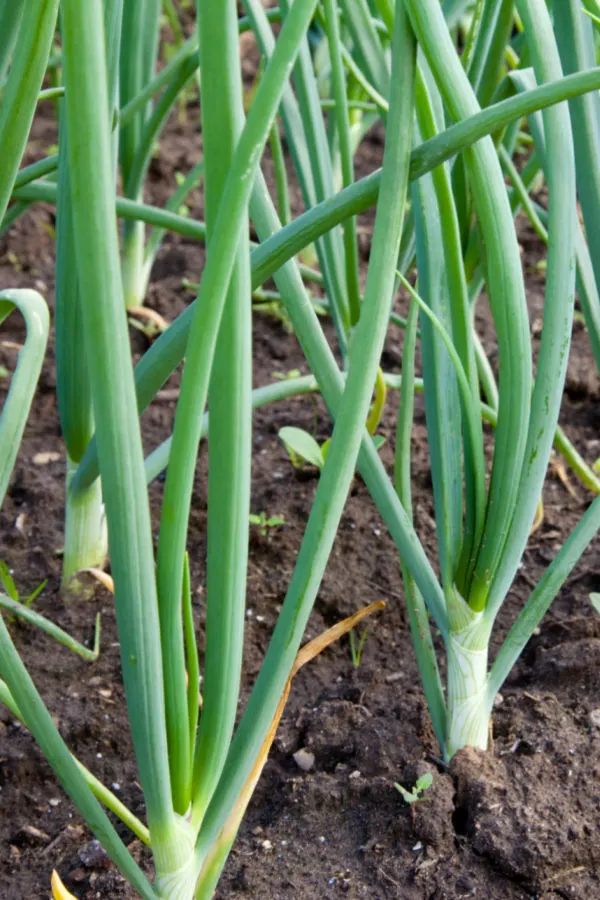
Unfortunately, most garden soil is not loose enough to allow for good drainage for onions. And although it might contain a good level of nutrients, adding a bit more can really make the difference for onions. Luckily, there is a way to increase both the fertility and drainage of your soil quite easily when planting onions with two simple materials – compost and sand.
When planting onions, adding compost and sand in with the existing soil can create the perfect growing medium for success. The compost adds power that is easy to absorb. It also creates a soil that can absorb moisture without becoming saturated. Affiliate Product Link : Uncle Charlies Bagged Compost
The sand is important too as it helps both lighten the soil mix for easy growing and helps to drain away excess moisture when there is too much present.
How To Plant With Sand & Compost – The Secrets To Planting Onion Sets In The Spring
If growing in trench rows, first trench your soil down to about four inches in depth. Next add about a half inch of sand and two inches of compost to the trench, mixing the two together as you do.
Next, plant your onions set bulbs down into the mix with the pointy end up. This is the sprouting end and makes it easy for the onion bulb to sprout straight up. Plant the bulb into the compost/sand mix so the top is about 1.5 inches from the surface of the soil. To finish, fill in the soil in the trench and water in so the soil is moist but not saturated.
If planting your onion bulbs in holes, dig a planting hole down to four inches that is roughly two inches in diameter. Fill the hole with a mix of 1/2 inch of sand and a few inches of compost. Finish by planting down in with the point up. Plant so the top of the bulb is again about 1.5 inches from the soil surface. Cover with the remaining garden soil and water in.
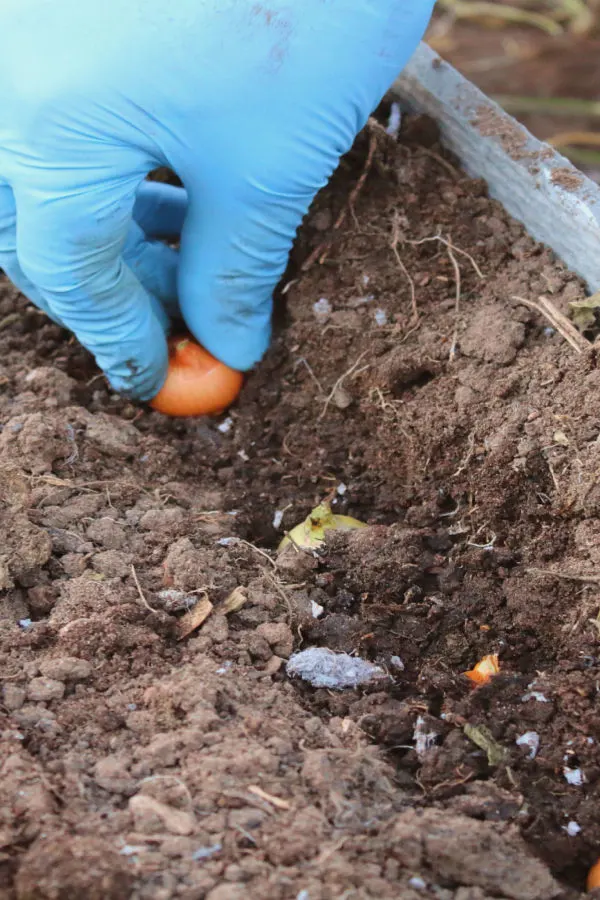
The sand/compost mixture will have your onions sprouting fast and absorbing nutrients with ease. Now all that is left is to mulch your crop to keep competing weeds at bay!
Mulching – The Secrets To Planting Onion Sets In The Spring
Keeping your onion set crop mulched will help keep moisture in, and weeds out. And nothing will keep a crop of onions from reaching their full potential like competing weeds! They not only steal nutrients, the roots of the weeds can interfere with bulb growth too.
Mulch the soil with a few inches of straw or shredded leaves at planting time. As the onions sprout and grow, continue to add more mulch to have four inches of mulch covering the soil. The good news is that beyond mulching, your onion crop will require little else!
The compost will provide more than enough nutrients. In fact, it is best not to fertilize your onions once growing as it can actually cause too much growth too early and lead to early bolting. As for water, onions need about one inch of water per week, via rain or by watering.
Follow Our Facebook Page For Great Gardening Tips And Advice! This Is My Garden Facebook Page
This Is My Garden is a garden website created by gardeners, for gardeners. Jim and Mary Competti have been writing gardening, DIY and recipe articles and books and speaking for over 15 years from their 46 acre Ohio farm. They publish three articles every week, 52 weeks a year. Sign up today to follow via email, or follow along!

